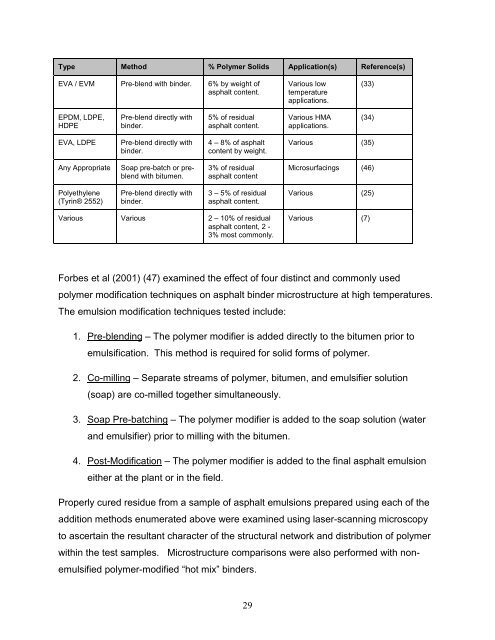Using Polymer Modified Asphalt Emulsions in Surface Treatments A ...
Using Polymer Modified Asphalt Emulsions in Surface Treatments A ...
Using Polymer Modified Asphalt Emulsions in Surface Treatments A ...
Create successful ePaper yourself
Turn your PDF publications into a flip-book with our unique Google optimized e-Paper software.
Type Method % <strong>Polymer</strong> Solids Application(s) Reference(s)<br />
EVA / EVM Pre-blend with b<strong>in</strong>der. 6% by weight of<br />
asphalt content.<br />
Various low<br />
temperature<br />
applications.<br />
(33)<br />
EPDM, LDPE,<br />
HDPE<br />
Pre-blend directly with<br />
b<strong>in</strong>der.<br />
5% of residual<br />
asphalt content.<br />
Various HMA<br />
applications.<br />
(34)<br />
EVA, LDPE<br />
Pre-blend directly with<br />
b<strong>in</strong>der.<br />
4 – 8% of asphalt<br />
content by weight.<br />
Various (35)<br />
Any Appropriate<br />
Soap pre-batch or preblend<br />
with bitumen.<br />
3% of residual<br />
asphalt content<br />
Microsurfac<strong>in</strong>gs (46)<br />
Polyethylene<br />
(Tyr<strong>in</strong>® 2552)<br />
Pre-blend directly with<br />
b<strong>in</strong>der.<br />
3 – 5% of residual<br />
asphalt content.<br />
Various (25)<br />
Various Various 2 – 10% of residual<br />
asphalt content, 2 -<br />
3% most commonly.<br />
Various (7)<br />
Forbes et al (2001) (47) exam<strong>in</strong>ed the effect of four dist<strong>in</strong>ct and commonly used<br />
polymer modification techniques on asphalt b<strong>in</strong>der microstructure at high temperatures.<br />
The emulsion modification techniques tested <strong>in</strong>clude:<br />
1. Pre-blend<strong>in</strong>g – The polymer modifier is added directly to the bitumen prior to<br />
emulsification. This method is required for solid forms of polymer.<br />
2. Co-mill<strong>in</strong>g – Separate streams of polymer, bitumen, and emulsifier solution<br />
(soap) are co-milled together simultaneously.<br />
3. Soap Pre-batch<strong>in</strong>g – The polymer modifier is added to the soap solution (water<br />
and emulsifier) prior to mill<strong>in</strong>g with the bitumen.<br />
4. Post-Modification – The polymer modifier is added to the f<strong>in</strong>al asphalt emulsion<br />
either at the plant or <strong>in</strong> the field.<br />
Properly cured residue from a sample of asphalt emulsions prepared us<strong>in</strong>g each of the<br />
addition methods enumerated above were exam<strong>in</strong>ed us<strong>in</strong>g laser-scann<strong>in</strong>g microscopy<br />
to ascerta<strong>in</strong> the resultant character of the structural network and distribution of polymer<br />
with<strong>in</strong> the test samples. Microstructure comparisons were also performed with nonemulsified<br />
polymer-modified “hot mix” b<strong>in</strong>ders.<br />
29
















